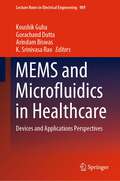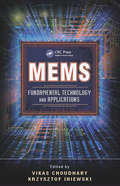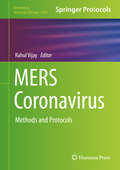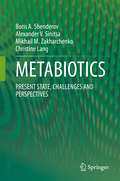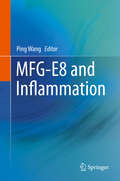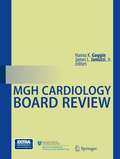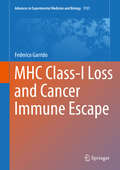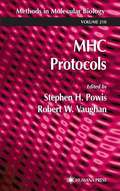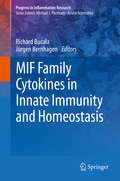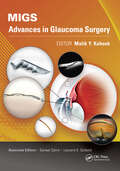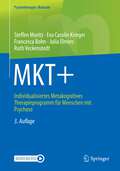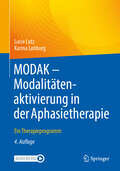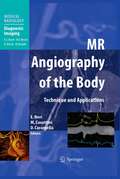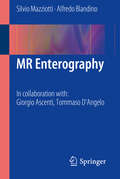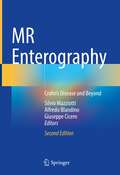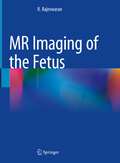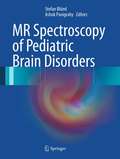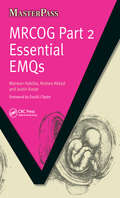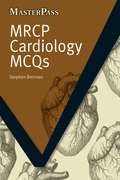- Table View
- List View
MEMS and Microfluidics in Healthcare: Devices and Applications Perspectives (Lecture Notes in Electrical Engineering #989)
by Arindam Biswas Gorachand Dutta Koushik Guha K. Srinivasa RaoThe book introduces the research significance of biomedical instrumentation and discusses micro-fabrication techniques utilized for biomedical devices. This book primarily focuses on the reader enlightenment on MEMS medical devices by introducing all the diagnostic devices and treatment tools at one place. The book covers in-depth technical works and general introductions to the devices such that the book can reach technical as well as non-technical readers.
MEMS: Fundamental Technology and Applications (Devices, Circuits, and Systems #15)
by Krzysztof Iniewski Vikas ChoudharyThe microelectromechanical systems (MEMS) industry has experienced explosive growth over the last decade. Applications range from accelerometers and gyroscopes used in automotive safety to high-precision on-chip integrated oscillators for reference generation and mobile phones. MEMS: Fundamental Technology and Applications brings together groundbreaking research in MEMS technology and explores an eclectic set of novel applications enabled by the technology. The book features contributions by top experts from industry and academia from around the world. The contributors explain the theoretical background and supply practical insights on applying the technology. From the historical evolution of nano micro systems to recent trends, they delve into topics including: Thin-film integrated passives as an alternative to discrete passives The possibility of piezoelectric MEMS Solutions for MEMS gyroscopes Advanced interconnect technologies Ambient energy harvesting Bulk acoustic wave resonators Ultrasonic receiver arrays using MEMS sensors Optical MEMS-based spectrometers The integration of MEMS resonators with conventional circuitry A wearable inertial and magnetic MEMS sensor assembly to estimate rigid body movement patterns Wireless microactuators to enable implantable MEMS devices for drug delivery MEMS technologies for tactile sensing and actuation in robotics MEMS-based micro hot-plate devices Inertial measurement units with integrated wireless circuitry to enable convenient, continuous monitoring Sensors using passive acousto-electric devices in wired and wireless systems Throughout, the contributors identify challenges and pose questions that need to be resolved, paving the way for new applications. Offering a wide view of the MEMS landscape, this is an invaluable resource for anyone working to develop and commercialize MEMS applications.
MERS Coronavirus: Methods and Protocols (Methods in Molecular Biology #2099)
by Rahul VijayThis volume provides various techniques and methodologies currently used in the study of MERS-CoV. Chapters are divided into four parts detailing evolution and entry of MERS-coronavirus, genetic alteration and structural determination of MERS-coronavirus proteins, quantitation of virus and anti-viral factors, and mouse models for MERS -coronavirus. Written in the highly successful Methods in Molecular Biology series format, chapters include introductions to their respective topics, lists of the necessary materials and reagents, step-by-step, readily reproducible laboratory protocols, and tips on troubleshooting and avoiding known pitfalls. Authoritative and cutting-edge, MERS Coronavirus: Methods and Protocols aims to ensure successful results in the further study of this vital field.
METABIOTICS: PRESENT STATE, CHALLENGES AND PERSPECTIVES
by Christine Lang Boris A. Shenderov Alexander V. Sinitsa Mikhail M. ZakharchenkoAimed at students, researchers, nutritionists, and developers in food technology, this research text addresses the nascent field of metabiotics. Metabiotics are products based on components of cells, metabolites, and signaling molecules released by probiotic strains, engineered to optimize host-specific physiological functions in a way that traditional probiotics cannot. This book examines the history, processes, design, classifications, and functions of metabiotics. It includes an overview of the composition and function of the gut microbiota, and discusses development of target-specific metabiotics. Further coverage includes comparisons to traditional probiotics, as well as probiotic safety and side-effects. Metabiotics: Present State, Challenges and Perspectives provides a complete history and understanding of this new field, the next phase of the probiotic industry.
MFG-E8 and Inflammation
by Ping WangAfter the discovery of milk fat globule-epidermal growth factor-factor 8 (MFG-E8) about two decades ago, a new era of delineating its potential beneficial role in several inflammatory diseases has begun to spout from the bench to translational research. In MFG-E8 and Inflammation, the editor and contributors have gathered a remarkable collection covering novel discoveries on the rapidly growing field of MFG-E8 and Inflammation which includes not only the findings from their individual lobotomies, but also from a host of pioneering researchers of this field. MFG-E8 and Inflammation starts by describing the origin, structure, expression, functions and regulation of MFG-E8, and then continues thoughtfully exploring its potentiality as a marker for apoptotic, stressed and activated cells. The topics cover the cellular and physiological function of MFG-E8, especially its role in efficient phagocytosis of apoptotic cells, intestinal barrier function, blood cell homeostasis and coagulation, and in the maintenance of the intact vascular system. The role of MFG-E8 in macrophages, neutrophils, lymphocytes, dendritic cells, platelets, as well as non-hematopoietic cells is adequately described in the book. The chapters also contain several lucid discussions on the recent discoveries of the roles of MFG-E8 in the autoimmune diseases, sepsis, tissue ischemia-reperfusion, hemorrhage, inflammatory bowel diseases, acute lung injury, asthma, lung fibrosis, stroke, prion diseases and Alzheimer's diseases with the potential focus on elucidating novel mechanistic pathways. MFG-E8 and Inflammation is an indispensable resource for scientists and clinical researchers working on fundamental or applied aspects of MFG-E8 pathobiology. This book explores, dissects and reviews several noteworthy findings and striking future perspectives which not only rewrite the disease pathophysiology, but also update our understanding towards attaining novel therapeutic potentials against various inflammatory diseases.
MGH Cardiology Board Review
by Hanna K. Gaggin James L. Januzzi Jr.MGH Cardiology Board Review is intended for physicians studying for the Cardiology Board Examination (Initial Certification or Re-certification) and for any busy practitioners who would like to review high-yield cardiology such as those in cardiology, emergency medicine, internal medicine, family practice, or even surgery. Designed for those on the go, each section is meant to be completed in 30 minutes; and at 30 minutes a day, the reader will have a complete overview of up-to-date information in 30 days. Each section has a concise didactic followed by a questions section with an identical format to the Cardiovascular Board Examination of the American Board of Internal Medicine.This book is from the Massachusetts General Hospital's Cardiology Division, one of the most respected cardiology programs in the world and is its first Cardiology review book.
MGH Cardiology Board Review
by Hanna K. Gaggin James L. Januzzi Jr.This comprehensively revised new edition prepares the reader for the cardiology board examination, as well as provide a concise review of the essentials of general cardiology and the less common but clinically relevant topics in a dynamic and time-efficient manner, augmenting existing learning. It uses board-style questions and answers at the end of each topic, enabling readers to test their learning and commit key concepts to long-term memory. Instructive figures and tables are used to consolidate teaching points. This book also contains practical tips from recent board exam takers and other resources in order to make best use of the reader’s limited time. In the MGH Cardiology Board Review, the Editors have compiled the expertise of over 60 experienced authors in a succinct volume, applying methods thoroughly tested in Board Review. In addition, two very important sections on ECGs and images are included, contents of which are derived from the board examination answer keys, the very ones that readers are expected to know. Plans on how to best approach board examination preparation and what additional resources to go to are provided. In short, this book has all the strengths to ensure your success on the boards exam.
MHC Class I Antigens In Malignant Cells
by Teresa Cabrera Natalia Aptsiauri Angel Miguel Garcia-LoraAbnormal expression of MHC class I molecules in malignant cells is a frequent occurrence that ranges from total loss of all class I antigens to partial loss of MHC specific haplotypes or alleles. Different mechanisms are described to be responsible for these alterations, requiring different therapeutic approaches. A complete characterization of these molecular defects is important for improvement of the strategies for the selection and follow-up of patients undergoing T-cell based cancer immunotherapy. Precise identification of the mechanism leading to MHC class I defects will help to develop new personalized patient-tailored treatment protocols. There is significant new research on the prevalence of various patterns of MHC class I defects and the underlying molecular mechanisms in different types of cancer. In contrast, few data is available on the changes in MHC class I expression during the course of cancer immunotherapy, but the authors have recently made discoveries that show the progression or regression of a tumor lesion in cancer patients undergoing immunotherapy depends on the molecular mechanism responsible for the MHC class I alteration and not on the type of immunotherapy used. According to this notion, the nature of the preexisting MHC class I lesion in the cancer cell has a crucial impact on determining the final outcome of cancer immunotherapy. This SpringerBrief will present how MHC class 1 is expressed, explain its role in tumor progression, and its role in resistance to immunotherapy.
MHC Class-I Loss and Cancer Immune Escape (Advances in Experimental Medicine and Biology #1151)
by Federico GarridoThis book is about the escape strategies used by cancer cells to avoid the immune response of the host. The main characters of this story are the “Antigen Presenting Molecules” and the “T Lymphocytes”. The former are known as the Major Histocompatibility Complex (MHC): the H-2 and the HLA molecules. The latter are a subgroup of white cells travelling all over our body which are capable to distinguish between “self and non self”. Readers will know from the inside about the history of the HLA genetic system and will discover how T lymphocytes recognize and destroy cancer cells. One of the key important questions is: Why tumors arise, develop and metastasize? This book tries to answer this question and will explain how cancer cells become invisible to killer T lymphocytes. The loss of the HLA molecules is a major player in this tumor escape mechanism. Cancer immunotherapy is aimed at stimulating T lymphocytes to destroy tumor cells. However, the clinical response rate is not as high as expected. The molecular mechanisms responsible for MHC/HLA antigen loss play a crucial role in this resistance to immunotherapy. This immune escape mechanism will be discussed in different types of tumors: lung, prostate, bladder and breast…ect. as well as melanoma and lymphoma. This book will be useful to Oncologists, Pathologists and Immunologist that will enter this fascinating area of research. It will be also interesting for biologist, doctoral students and medical residents interested in “Tumor Immunology”.
MHC Protocols
by Stephen H. Powis Robert W. VaughanA collection by leading experts detail of readily reproducible methods for identifying polymorphisms in the human MHC. Described in step-by-step detail to ensure robust and successful experimental results, these techniques provide DNA-based protocols for the study of polymorphism in HLA class I and II genes and in non-HLA HMC genes associated with human disease (TAP1, TAP 2, C2, C4, and TNF- a). The authors also describe methods for accessing HLA sequence data from electronic databases designed to catalog HLA-region genes and their alleles.
MIF Family Cytokines in Innate Immunity and Homeostasis
by Richard Bucala Jürgen BernhagenThe role of the cytokine macrophage migration inhibitory factor (MIF) in the immune response and in the immunopathogenesis of different inflammatory, autoimmune, and infectious disorders is now well-established. Recent studies continue to broaden considerably the role of MIF in both normal physiology and pathology, which range from such diverse areas as oncogenesis, metabolism, and cellular stress responses. MIF's molecular mechanism of action in these contexts is becoming increasingly understood and the role of variant MIF alleles in different conditions continues to be defined. New family members, such as D-dopachrome tautomerase, or MIF-2, and the closely homologous genes encoding by parasites have been defined and are being functionally characterized. MIF directed therapies also are entering clinical testing and ultimately may be applied in a pharmacogenomics manner. This book provides a comprehensive synthesis of the state-of-the-art of MIF science. The intended audience are post-graduate students and researchers in inflammation, innate immunity, immunology, and immunopathology.
MIGS: Advances in Glaucoma Surgery
by Malik KahookWith a revolution in the surgical management of mild to moderate glaucoma, new procedures allow for the use of microinvasive techniques that avoid disruption of the conjunctiva and formation of a bleb. These approaches range from laser therapies targeting the outflow system of the eye to the implantation of miniature devices in Schlemm’s canal or the suprachoroidal space. The emergence of this new branch of glaucoma surgery, often coupled with micro-incisional cataract surgery, requires the practicing surgeon to learn about anatomical nuances to ensure success.MIGS: Advances in Glaucoma Surgery will aid the novice resident as well as the seasoned ophthalmic surgeon facing these new issues in glaucoma treatment. The book addresses preoperative patient selection advice, intraoperative pearls for success, and post operative management skills, which are some of the important aspects of the process towards the adoption of MIGS.Why you will want to read MIGS: Advances in Glaucoma Surgery:• Forward thinking contributions from seasoned MIGS experts who have intimate knowledge of the devices benefits and potential pitfalls in their use• Basic knowledge is provided that will allow each surgeon to tailor their treatment plan while leveling the learning curve• Assists in indentifying patients with a milder form of the disease and higher target pressures who may benefit from the MIGS devicesMIGS: Advances in Glaucoma Surgery is the first book of its kind to cover the range of devices in this arena using expert contributors and offering real world pearls for practice that can be used in the operating room. Practicing cataract and glaucoma physicians, residents, and fellows will benefit from this timely resource as the thought process for how to treat glaucoma has advanced.
MKT+: Individualisiertes Metakognitives Therapieprogramm für Menschen mit Psychose (Psychotherapie: Manuale)
by Steffen Moritz Francesca Bohn Ruth Veckenstedt Eva Carolin Krieger Julia ElmersMit dem MKT+ wird ein Therapiekonzept vorgelegt, das bewährte Techniken der kognitiven Verhaltenstherapie bei Psychosen mit innovativen metakognitiven Elementen verbindet: Betroffene werden vom Therapeuten angeleitet, „Denkfallen“ zu erkennen, die Positivsymptome – aber auch andere Symptome im Rahmen einer Psychose – begünstigen, und diese zu entschärfen. Mit einer Fülle an kreativen Übungen und Evaluationsinstrumenten ist das Buch eine Fundgrube für Therapeutinnen und Therapeuten. Eine Vielzahl an Fallbeispielen und Formulierungsvorschlägen erleichtert auch weniger erfahrenen Kolleginnen und Kollegen den Einstieg in die Therapie mit Menschen mit Psychose.Die dritte Auflage wurde vollständig überarbeitet und um neue Interventionen erweitert, insbesondere um eine neue Therapieeinheit zur Bearbeitung von belastendem Stimmenhören. Diese zielt u.a. auf die Entwicklung von Coping-Strategien, hilfreicheren Bewertungen des Stimmenhörens sowie der Auseinandersetzung mit deren Inhalten und möglichen Ursachen ab.
MMR and Autism: What Parents Need to Know
by Michael FitzpatrickThe MMR controversy has been characterized by two one-sided discourses. In the medical world, the weight of opinion is overwhelmingly in favour of MMR. In the public world, the anti-MMR campaign has a much greater influence, centred on the fears of parents that the triple vaccine may cause autism in their children. Both professionals and parents struggle to cope with the anxieties this creates, but find it difficult to find a balanced account of the issues.In MMR and Autism Michael Fitzpatrick, a general practitioner who is also the parent of an autistic child, explains why he believes the anti-MMR campaign is misguided in a way that will reassure parents considering vaccination and also relieve the anxieties of parents of autistic children. At the same time, this informative book provides health care professionals and health studies students with an accessible overview of a contemporary health issue with significant policy implications.
MODAK - Modalitätenaktivierung in der Aphasietherapie: Ein Therapieprogramm
by Luise Lutz Karina LønborgDieses Praxisbuch zeigt, wie durch die Aktivierung der vier Sprachmodalitäten Sprechen, Verstehen, Lesen und Schreiben die kommunikativen Fähigkeiten von Aphasiepatienten individuell gestärkt werden können. Im Mittelpunkt der Therapie stehen die persönlichen Interessen und Lebensumstände der Betroffenen. Die Behandlung erfolgt sowohl symptomorientiert als auch den tieferliegenden neurophysiologischen Störungen entsprechend. So ist es möglich, die Therapie auf alle Schweregrade der Aphasie anzupassen. Mit der MODAK-Therapie können Sie die sprachlichen Fähigkeiten Ihrer Patienten mit Aphasie fördern und deren kommunikativen Kompetenzen weiterentwickeln. Aus dem InhaltNeurophysiologische und neurolinguistische Grundlagen zur „Modalitätenaktivierung“Detaillierte Anleitung für die Durchführung der TherapieNeu in der 4. Auflage: zwei weitere Kapitel zur Umsetzung des Konzepts in der Gruppentherapie und Arbeit mit Angehörigen, Arbeitsmaterial mit 172 Situationsbildern zum Download und Links zu Videos Für Logopädie, Sprachheilpädagogik und klinische Linguistik das perfekte Werkzeug zur Planung und Durchführung der komplexen Behandlung aphasischer Störungen.
MR Angiography of the Body
by Mirco Cosottini Davide Caramella Emanuele NeriMagnetic resonance angiography (MRA) continues to undergo exciting technological advances that are rapidly being translated into clinical practice. It also has evident advantages over other imaging modalities, including CT angiography and ultrasonography. With the aid of numerous high-quality illustrations, this book reviews the current role of MRA of the body. It is divided into three sections. The first section is devoted to issues relating to image acquisition technique and sequences, which are explored in depth. The second and principal section addresses the clinical applications of MRA in various parts of the body, including the neck vessels, the spine, the thoracic aorta and pulmonary vessels, the heart and coronary arteries, the abdominal aorta and renal arteries, and peripheral vessels. The final section considers the role of MRA in patients undergoing liver or pancreas and kidney transplantation. This book will be an invaluable aid to all radiologists who work with MRA.
MR Enterography
by Silvio Mazziotti Alfredo BlandinoIn recent years, there has been huge interest in developing new methods that offer improved accuracy for the detection of small bowel pathology, and in particular for the assessment of inflammatory bowel diseases (IBD). Cross-sectional imaging, such as CT and MR, has advantages over traditional barium fluoroscopic techniques in terms of direct visualization of the bowel wall and improved visualization of extraluminal findings and complications. This means a complete change in the diagnostic approach to the patient with IBD: from analysis of the bowel surface to direct evaluation of parietal alterations and assessment of peri and extraintestinal involvement. The ideal imaging test is reproducible, well tolerated by patients and, above all, free of ionizing radiation. MR enterography, currently performed only in a few reference centers, meets these criteria and offers accurate diagnosis, particularly in respect of the wide spectrum of intra and extraintestinal complications of IBD. This book provides a thorough overview of the indications, techniques, diagnostic advantages and limitations of MR enterography. Particular attention is paid to patient preparation in relation to the particular study type and to the potential advantages of the most up-to-date MR studies in specific cases, e. g. , allergy or renal failure. A separate chapter is devoted to MR of perianal region for the detection and staging of perianal fistula, a common complication in patients with Crohn's disease. Numerous high-quality illustrations are included and help to ensure that the book will be a valuable source of information for every radiologist involved in abdominal MR imaging.
MR Enterography
by Silvio Mazziotti Alfredo BlandinoIn recent years, there has been huge interest in developing new methods that offer improved accuracy for the detection of small bowel pathology, and in particular for the assessment of inflammatory bowel diseases (IBD). Cross-sectional imaging, such as CT and MR, has advantages over traditional barium fluoroscopic techniques in terms of direct visualization of the bowel wall and improved visualization of extraluminal findings and complications. This means a complete change in the diagnostic approach to the patient with IBD: from analysis of the bowel surface to direct evaluation of parietal alterations and assessment of peri and extraintestinal involvement. The ideal imaging test is reproducible, well tolerated by patients and, above all, free of ionizing radiation. MR enterography, currently performed only in a few reference centers, meets these criteria and offers accurate diagnosis, particularly in respect of the wide spectrum of intra and extraintestinal complications of IBD.This book provides a thorough overview of the indications, techniques, diagnostic advantages and limitations of MR enterography. Particular attention is paid to patient preparation in relation to the particular study type and to the potential advantages of the most up-to-date MR studies in specific cases, e.g., allergy or renal failure. A separate chapter is devoted to MR of perianal region for the detection and staging of perianal fistula, a common complication in patients with Crohn’s disease. Numerous high-quality illustrations are included and help to ensure that the book will be a valuable source of information for every radiologist involved in abdominal MR imaging.
MR Enterography: Crohn’s Disease and Beyond
by Silvio Mazziotti Alfredo Blandino Giuseppe CiceroThis second edition is primarily dedicated to MR-Enterography, an imaging modality whose reliability for intestinal assessment in patients suffering from inflammatory bowel diseases has gained increasing consensus.The performance of this technique has been significantly enlarged over the last years, due to its undoubted advantages in terms of exhaustive evaluation of the abdominal cavity and safeness due to the lack of radiation exposure. The first part is focused on MR-Enterography standard protocol. Nevertheless, additional sequences, technical novelties and common pitfalls are reported and discussed. In the second section, the typical intestinal and extra-intestinal findings related to Crohn’s disease are described in detail. In this edition, more emphasis has been put on practical topics, useful in the daily clinical practice: anatomical changes after surgical procedures, structured reporting and emerging clinical applications over inflammatory bowel diseases.Another part is dedicated to Magnetic Resonance Imaging of the anal canal, including technical aspects and clinical implications.The text is largely complemented by diagnostic images. Nonetheless, at the end of the book 30 illustrated cases show different clinical scenarios evaluated with MR-Enterography and Magnetic Resonance Imaging of the anal canal.
MR Imaging of the Fetus
by R. RajeswaranThis book presents the anatomy and MRI features of the normal fetus and describes the anomalies of each system in a systematic way. The normal fetal brain at different gestational ages is also extensively illustrated. It features a treasure of MR images illustrating several clinical conditions. Sonographic images, line diagrams and post-natal images are supplemented for easy learning. It also addresses the differential diagnoses and prognostic indicators of the various fetal anomalies.This book will help the consultants and postgraduates of radiology, obstetrics, fetal medicine and pediatrics in understanding various fetal anomalies and in patient counseling.
MR Spectroscopy of Pediatric Brain Disorders
by Ashok Panigrahy Stefan BlümlMagnetic resonance spectroscopy (MRS) is a modality available on most clinical MR scanners and readily integrated with standard MR imaging (MRI). For the brain in particular, MRS has been a powerful research tool providing additional clinically relevant information for several disease families such as brain tumors, metabolic disorders, and systemic diseases. The most widely-available MRS method, proton (1H; hydrogen) spectroscopy, is FDA approved for general use in the US and can be ordered by clinicians for patient studies if indicated. There are several books available that describe applications of MRS in adults. However, to the best of our knowledge there is currently no book available that focuses exclusively on applications in pediatrics. MR spectroscopy in the pediatric population is different from adults for two main reasons. Particularly in the newborn phase the brain undergoes biochemical maturation with dramatic changes of the "normal" biochemical fingerprint. Secondly, brain diseases in the pediatric population are different from adult disorders. For example, brain tumors, which are mostly gliomas in the adults, often originate from different cell types and are also more diverse even within the same type and grade of tumor. This diversity of diseases and its implications for MR spectroscopy has not been addressed sufficiently in the literature, we believe. The target audience for "MR Spectroscopy of Pediatric Brain Disorders" are thus both clinicians and researchers involved with pediatric brain disorders. This includes radiologists, neurologists, neurooncologists, neurosurgeons, and more broadly the neuroscience and neurobiology community. This book will provide the necessary background information to understand the basics of MR spectroscopy. This will be followed by a detailed discussion of the normal biochemical maturation which will highlight the metabolic differences between the pediatric and adult brain. Thereafter, in SECTION I individual chapters will address various pediatric brain disease families. Of particular importance for pediatrics are case studies. For that reason, SECTION II will contain a large number of case studies. This will be particularly important for clinicians who may want to see examples of MRS for various conditions. A standardized format will be used for case reports that allow the reader to quickly understand the history of each case presented and the significance of the findings. The case reports will also include information from other imaging modalities to point out any added value of MRS in addition to conventional studies and clinical information. This section is necessary because the format of providing more complete information about individual patients is not practical for the chapters in SECTION I.
MRC Psych Part 1 In a Box
by Bhaskar Punukollu MBBS MRCPsych Michael Phelan BSc MBBS MRCPsych Anish Unadkat BMBS BmedsciExam-specific question and answer cards, using standard question formats from the Royal College exams, these cards make exam preparation time as efficient and straightforward as possible. They also lend. themselves studying with a partner or colleague. They are aimed specifically at candidates taking the first part of the examination for the Membership of the Royal College of Psychiatrists (MRCPsych Part 1) and provide a condensed review of highly relevant information for the exam. Key areas covered are Psychopathology; neuroscience; neurotic, stress related and somatoform disorders; schizophrenia and other psychoses; affective disorders; psycho-pharmacology; psychology; psychotherapy; and dementia syndromes. The first nine sections of cards are broadly divided into commonly tested areas on the exam: 1. Neurotic disorders 2. Affective disorders 3. Dementia syndromes 4. Neuropsychiatry 5. Psychology 6. Psychotherapy 7. Schizophrenia 8. Pharmacology 9. Human development
MRCOG: Pt. 2, 2008 (MasterPass)
by Marwan Habiba Andrea Akkad Justin KonjeThis title includes Foreword by David Taylor, Professor and Vice Dean of Leicester Medical School. Preparing for the Part 2 MRCOG examination remains a daunting and complex task, particularly as learning and revision often need to fit around clinical commitments. Much has been written about how to prepare for and pass exams, yet it remains surprising how often well-read candidates provide unsatisfactory answers in areas which they know well. Clearly, a sound understanding of the topic area is essential, but deeper knowledge also increases uncertainty, and the vast developments in the field mean that proficiency in all areas is next to impossible. Thus a critical point for postgraduate candidates, who more often than not will prepare for the examination in isolation, is to develop a real understanding of what the examination is meant to assess...This revision aid in obstetrics and gynaecology is based on the Extended Matching Question format (EMQ). It contains forty-two questions of varying degrees of difficulty, along with detailed answers. "MRCOG Part 2 Essential EMQs" is an indispensable study and revision aid for postgraduate medical students preparing for Part 2 of the Membership of the Royal College of Gynaecologists (MRCOG) examination or equivalent. "The number of published revision aids including this question format in postgraduate Obstetrics and Gynaecology remains limited. With this book we wanted to produce a comprehensive selection of EMQ, covering broad areas relevant to the speciality, which would be useful those preparing for postgraduate examinations at Part 2 MRCOG level or equivalent." - Marwan Habiba, Andrea Akkad, Justin Konje.
MRCP Cardiology MCQs (MasterPass)
by Brennan StephenCardiology is a large and critical branch of internal medicine, and as such covers a vast amount of the knowledge tested in Membership of the Royal Colleges of Physicians (MRCP) exams. This study guide contains 150 multiple choice questions (MCQs), each with various numbers of stem answers. The questions cover a wide range of both cardiology and cardiovascular pharmacology and encompass both basic anatomy and physiology of the heart, through to advanced topics such as evidence-based medicine. The questions are supplemented at the back of the book with explanatory answers to aid further revision and study.
MRCP Paces Ethics and Communication Skills
by Iqbal KhanNew primary care organisations are demanding personal and practice-based professional development plans to underpin revalidation of clinicians' professional registration or accreditation of practices. This workbook is unique in showing the reader how to combine and integrate the two and matches national guidelines that explain how to apply guidance in real life for maximum effect. With action plans key facts and references it emphasises how to prioritise learning needs provides examples of plans and focuses on a variety of clinical and organisational topics. It will enable general practitioners nurses therapists and practice managers to design and apply personal development plans as individuals and as multidisciplinary practice teams.
